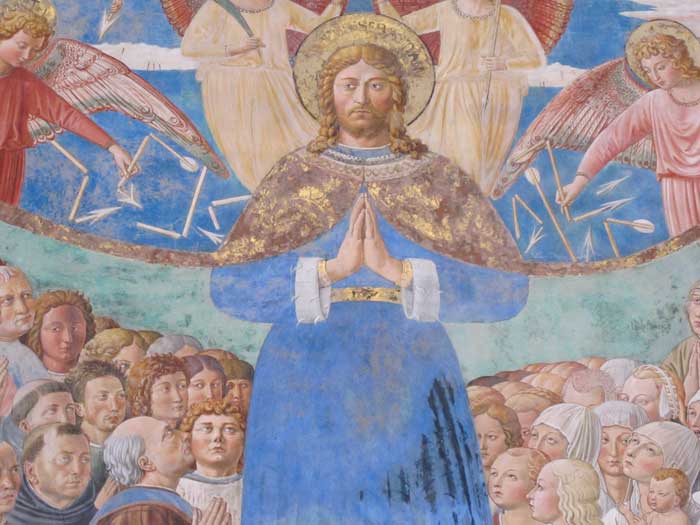 |
| Benozzo Gozzoli, Saint Sebastian, 1464-1465, fresco (detail), San Gimignano, San’Agostino |
Saint Sebastian |
| In the church of Saint Augustine, Benozzo created a votive fresco commissioned by the Augustinians following the plague that struck the town in 1464. It is certain that, in order to carry out this work, the artist broke off his decoration of the main chapel with the Episodes from the life of Saint Augustine. The iconography of this fresco is quite unusual compared to traditional representations in which Saint Sebastian is clad only in a loincloth and tied to a tree or column. Here, the saint is shown standing on a pedestal supported by angels and dressed in a tunicle tied at the waist and a large cloak opened to protect the population praying at his feet, as indicated by inscription on the pedestal, which reads SANCTE SEBASTIANE INTERCEDE PRODEVOTO POPOLO TVO. Another inscription on the painted marble floor indicates the date of completion as 28th July 1464.[1] |
Along with the original commission to fresco the choir of Sant'Agostino in San Gimignano, Gozzoli received a number of other requests, including two 'Pestbilder' (a painted prayer against the plague). For the Sant'Agostino, Gozzoli created a votive fresco showing St Sebastian Intercessor on the southern nave wall. This work was painted during the outbreak of the plague in 1464, as we are informed by the inscription on the saint's pedestal. This would mean that Gozzoli interrupted the painting of the apsidal chapel in order to produce this picture.
|
||||
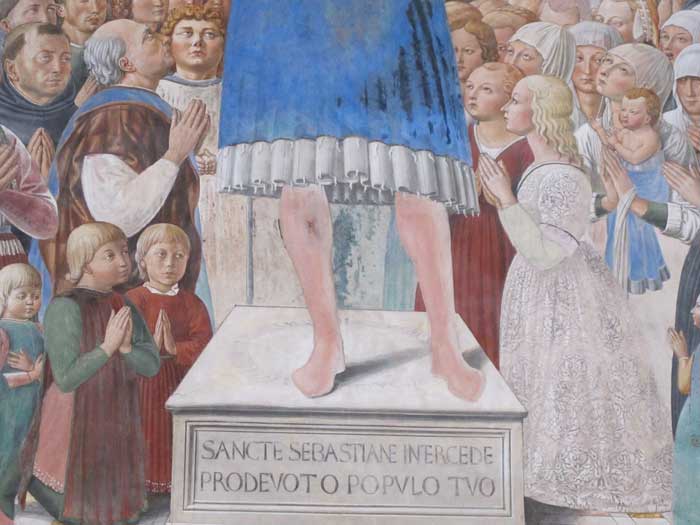 |
||||
Benozzo Gozzoli, Saint Sebastian, 1464-1465, fresco (detail), San Gimignano, San’Agostino
|
||||
 |
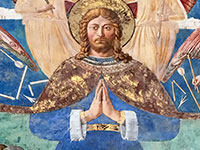 |
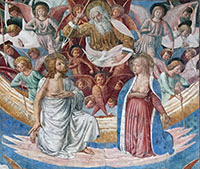 |
||
Benozzo Gozzoli, San Sebastiano, 1464
|
||||
| Gozzoli painted in San Gimignano another fresco of St Sebastian on the inner entrance wall of the collegiate church of Santa Maria Assunta. The work as commissioned by the city government in February 1465, six months after the plague epidemic. On this occasion the saint is depicted in accordance with the iconographical tradition of Italian art during the 15th century. The saint provided artist with an opportunity to depict a nude, which is why the theme was particularly popular from the Renaissance onwards. The arrows which his tormentors are pointing at him symbolize a sudden illness. The similarity of a body transfixed with arrows and that of a plague victim makes the choice of Sebastian as a plague saint appear plausible. Much of the painting was executed by assistants. |
||||
|
||||
| The Tabernacolo dei Giustiziati (The Tabernacle of those sentenced to death) is a small brick building located in the Municipality of Certaldo along the Via Francigena. It plays hosts to splendid frescos by the famed Florentine painter Benozzo Gozzoli. After completing important commissions in Florence, Umbria and Lazio, Gozzoli began working in San Gimignano illustrating the stories from the life of Saint Augustine for the church by the same name.
At this time, Certaldo’s vicars asked the artist to decorate this small church. Currently, its frescoes can be found in the ex-church of Santi Tommaso and Prospero in Certaldo Alto next to the Palazzo Pretorio. The structure dates back to 1400 and its name derived from the fact that it was used to comfort the condemned who were sentenced to capital punishment. The Vicar who commissioned these works was in charge of administering justice throughout the territory. The tabernacle’s frescoes are considered the prototype of all of Gozzoli’s frescos and his school carried out similar works in other buildings. The paintings depict religious scenes and figures such as ‘The Annunciation’, ‘God the Father and the Holy Spirit’s Dove with the Evangelists’, ‘The Crucifixion of Saint Sebastian’, ‘Jesus Preaching’, ‘The Deposition’ and ‘The Resurrection’. All of these works represent Faith’s victory over Evil and the artist’s deep religious sentiment. His decorative motifs, such as garlands, flower and laurel wreaths, follow the typical Renaissance style. |
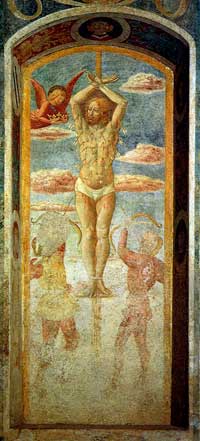 |
|||
|
Benozzo Gozzoli and his Workshop, Tabernacle of Giustiziati: Martyrdom of Saint Sebastian, 1467, fresco, Certaldo, Santi Michele e Jacopo |
|||
| [1] The martyrdom of St Sebastian Saint Sebastian (died c. 288) was a Christian saint and martyr, who is said to have been killed during the Roman emperor Diocletian's persecution of Christians. He is commonly depicted in art and literature tied to a post and shot with arrows. This is the most common artistic depiction of Sebastian; however, he was rescued and healed by Saint Irene of Rome before haranguing the emperor and being clubbed to death; his body was afterwards thrown into the sewer. The earliest representation of Sebastian is a mosaic in the Basilica of Sant'Apollinare Nuovo (Ravenna, Italy) dated between 527 and 565. Another early representation is in a mosaic in the Church of San Pietro in Vincoli (Rome, Italy), which was probably made in the year 682. It shows a grown, bearded man in court dress but contains no trace of an arrow. As protector of potential plague victims (a connection popularized by the Golden Legend[8]) and soldiers, Sebastian naturally occupied a very important place in the popular medieval mind, and hence was among the most frequently depicted of all saints by Late Gothic and Renaissance artists, in the period after the Black Death.[9] The opportunity to show a semi-nude male, often in a contorted pose, also made Sebastian a favourite subject. His shooting with arrows was the subject of the largest engraving by the Master of the Playing Cards in the 1430s, when there were few other current subjects with male nudes other than Christ. Sebastian appears in many other prints and paintings, although this was also due to his popularity with the faithful. Among many others, Botticelli, Perugino, Titian, Pollaiuolo, Giovanni Bellini, Guido Reni (who painted the subject seven times), Mantegna (three times), Hans Memling, Gerrit van Honthorst, Luca Signorelli, El Greco, Honoré Daumier, John Singer Sargent and Louise Bourgeois all painted Saint Sebastians. The saint is ordinarily depicted as a handsome youth pierced by arrows. There were predella scenes, when required, often of his arrest, confrontation with the Emperor, and final beheading. The illustration in the infobox is the Saint Sebastian of Il Sodoma, at the Pitti Palace, Florence. [2] Frescoes of saints on the pillars The two entrance pillars to the chapel round off the fresco paintings with four saints on each side. These eight saints represent an important addition to the life of St Augustine. Their portraits are placed in niches in order to create the impression that they are sculptures. The impression of painted sculptures is contradicted by the garments which extend beyond the painted architecture. On the northern pillar are St Monica, St Sebastian, St Bartolus and St Gimignano. On the southern pillar St Nicholas of Bari, St Fina, St Nicholas of Tolentino and Raphael and Tobias are depicted. The eight saints standing in niches on the fronts and sides of the choir pillars are important elements in the design. The four saints in the lower register, Sebastian, Bartolus, Nicholas of Tolentino and Tobias, are each provided with a story related to their lives. St Sebastian, who according to St Ambrose came from Milan, suffered his martyrdom in Rome at the end of the third century. He, one of the 14 auxiliary saints, is holding an arrow and a palm frond, attributes which identify him as a martyr. As an auxiliary saint in time of plague, his worship became increasingly important from the 14th century onwards. In keeping with the other pictures in the lower register, the composition includes a "historia" which relates to the life of the saint.
|
||||
|
Benozzo Gozzoli , St Sebastian (on the pillar), 1464-65, fresco, Apsidal chapel, Sant'Agostino, San Gimignano
|
|||

|
 |
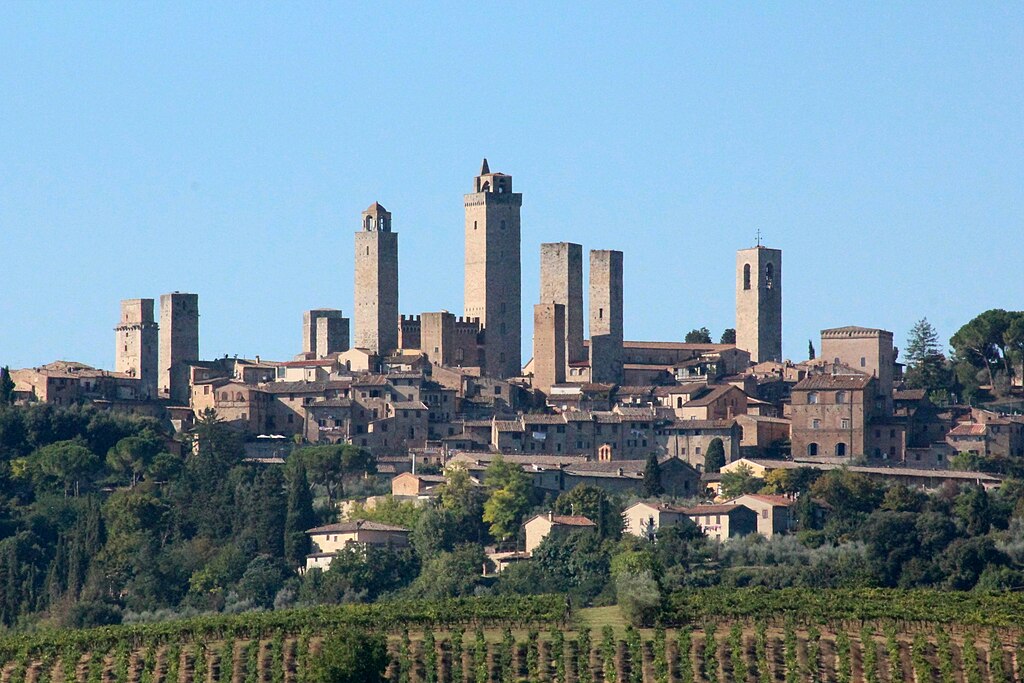 |
||
Chiesa di Sant'Agostino, San Gimignano, vista dalla Torre Grossa
|
San Gimignano, morning | San Gimignano, UNESCO World Heritage Site
|
||
|
||||
Holiday accomodation in Tuscany | Podere Santa Pia | Artist and writer's residency
|
||||
 |
||||
Podere Santa Pia |
Podere Santa Pia, garden view, April |
San Gimignano |
||
|
||||





